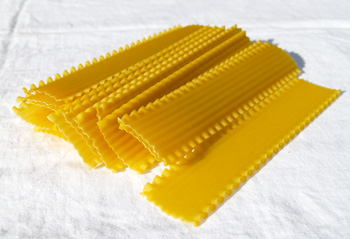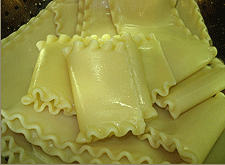 Lasagna
Lasagna© Denzil Green
Lasagna noodles are thick, wide noodles about 2 to 3 inches wide (5 to 7 cm.) The edges and faces can be either ruffled or smooth.
They are used for making baked pasta dishes with.
No-cook Lasagna Noodles
These have actually already been cooked for you.
Still, they have to absorb moisture from somewhere, and where they absorb it from is the tomato sauce and the cheese, so make the lasagne a bit more runnier going into the oven than you would otherwise by using more sauce or adding a bit of water to the sauce.
Though normally you would be careful anyway to cover all the noodles with sauce and filling, with these you need to be particularly so, or they will just remain dry.
Lasagne al forno
This is the classic pasta dish made with lasagna noodles. The noodles are used to separate layers of food, such as cheese, sauce and meat (though some modern versions use vegetables.) The dish is baked in the oven.
Southern Italian traditions will use tomato sauce with ricotta (Sicilican version) and / or meatballs. Most North Americans tend to make a combination of the Bolognese version and the Sicilian version, by substituting the bechamel sauce with ricotta or cottage cheese.
Some regional variations:
| Abruzzo | Made with pecorino and scamorza cheese. | |
| Emilia Romagna | Usually made in winter, with a Bolognese (meat) sauce, bechamel sauce and grated cheese (often referred to as a Bolognese version of lasagne.) | |
| Lazio | Made with bacon and broccoli. | |
| Liguria | Considered a summer dish. Made with pesto sauce and parmesan, often with bechamel sauce as well. | |
| Lombardy | Made with Gorgonzola and pine nuts. Portofino, in south-east Liguria, reputedly gets so many tourists from Lombardy, that a version there has evolved which combines the Ligurian lasagne style — using pesto — with the Lombard habit of using gorgonzola. | |
| Marche | Made with chicken liver and white truffles. | |
| Puglia | Made with broccoli and red peppers. | |
| Sardinia | Made with artichokes and pecorino sardo. | |
| Sicily | Made with eggplant and ricotta. | |
| Trentino | Mushrooms and Asiago cheese. | |
| Tuscany | Bolognese version (i.e. same as for Emilia Romagna.) | |
| Umbria | Vegetables and black truffles. | |
| Veneto | Radicchio and red wine. |
History Notes
Cooked lasanga noodles
Paula Trites
Etruscan paintings of banquets show the guests eating something like lasagne.
The Romans had wide noodles they called lagunae / laganum, though you could only really call these lasagna noodles if you called every wide noodle a “lasagna” noodle, as the Romans used theirs in soup.
Wealthy Romans would have fresh lagunae noodles made with eggs; normal people would have dried versions made without egg.
That much, at least, hasn’t changed.
Language Notes
The noodle is called “lasagna”. The dish is called “lasagne” (plural), as it uses many noodles.
In Naples, called “laganelle”; in Campania, “lagane”; in Calabria, “laganedde”; in Basilicata, “laane.”
Sources
Savastano, Ellen. Between the sheets. New Jersey, USA: Art Culinaire. Winter 2003.


